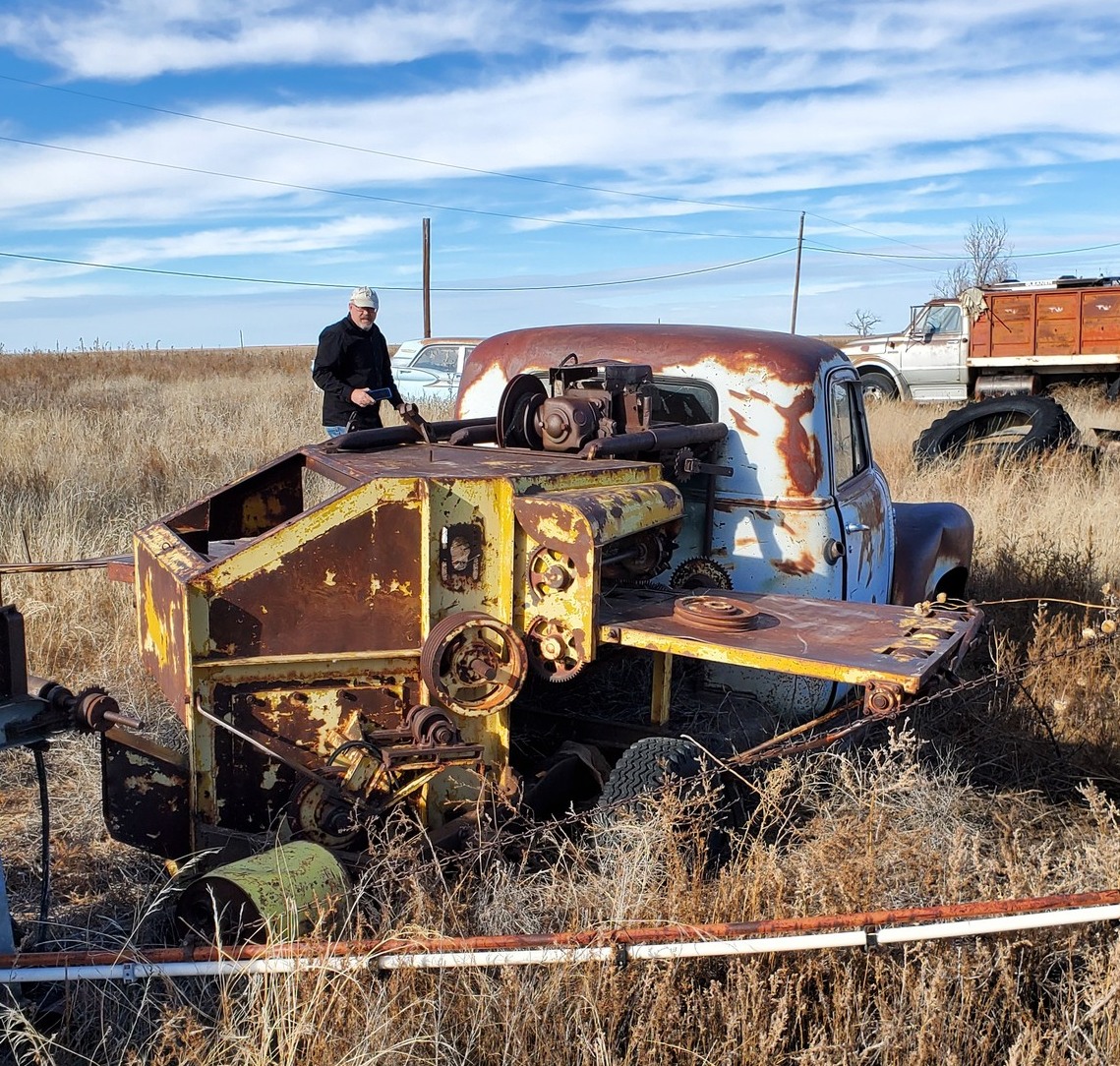By Steve “Sodbuster” Doner


Several months ago Kent Brooks and I were discussing that it was a shame that Baca County did not have any of the equipment from that bygone era in a place where people could learn of the tools of that industry. Most of the pictures we have of broomcorn seeders show the process and the crews at work, but there are no closeup pictures of a seeder and how it functioned and no historical displays of the equipment, where people can see the size and scale of the actual equipment and operation. So recently we set out on a search for any remaining seeders and balers.
We had heard rumors of a couple of museums having broom corn seeders, but as we begin to search our efforts came up empty. The Plains Indians & Pioneers Museum in Woodward, OK, for example, had some broom making equipment when I stopped there the last part of October but no seeder or baler. Same story with the museum at Limon, Colorado. We asked many others and Troy Bishop (Ray “Budge” Bishop’s grandson) informed us that he didn’t have any old equipment but pointed us to a couple balers at Challenger Farms (Schroeder); Pat Cooper had an old baler and part of an old seeder next to the old Morrison and Sons Broomcorn building west of the Springfield elevator; disappointingly the Cimarron Heritage Center in Boise City informed us they didn’t have a seeder; neither did Stanton County Museum in Johnson. Finally, the Morton County Museum in Elkhart said they had a seeder in perfect condition that we could photograph. So with much anticipation, on Dec. 20, we left Springfield, headed for Elkhart.

On the way we stopped at Kent’s cousin Bill Brooks house and we asked if he knew of any seeders. His immediate reply was, “Yes, I know where there are two seeders. There are two balers and a seeder on the old Schwietzer place that had belonged to Rich’s and a seeder at Gregory’s Red Ranch.” So for over two months we had been asking everyone across the county if they knew where a seeder was located and finally found two within a few miles of his cousin.








Update on Search for Broomcorn seeders.
In October, on a local Facebook page, Kent Brooks and I made an appeal to Baca Countians to help us locate broomcorn equipment, especially a seeder, so that we could photograph them closeup. All of the old pictures of seeding broomcorn do not show the workings of that machine in detail.
We are grateful to all of you for your suggestions and interest. We contacted or had wonderful visits with many of the names and museums you gave us: Leon Kerr, Dennis Dunivan, Kip Bitner, Elvin Shaffer, Anita and Troy Bishop; museums: Plains Indians & Pioneers Museum in Woodward, OK; Limon CO; Cimarron Heritage Center in Boise City, OK; Stanton County Museum in Johnson, KS, and all of them had either sold the equipment, loaned it and never got it back, or simply never had any.
The Gregory seeder chain with spring tensioned hold down that clasped the butt end of the broomcorn heads and held them fast a they passed through the spinning threshing cyclinders that removed the seed.
This is the steel table that was attached to the seeder’s feeding table where the broomcorn was brought from the “rick” and spreadout evenly and pushed along to insure that the “feeder man” could feed the heads into the seeder smoothly and evenly.
Bonnie Grahn shared a picture of two broomcorn balers she had at her farm and invited me for a visit to photograph them. They were two older “sweep” balers cleverly converted to hydraulics and mounted on an old ford truck frame. When I described them to Max Woolley, he thought they might be the set his dad, Doyle Woolley, had made. Max and I made a mad dash up to Grahn’s and sure enough, they were his dad’s, made exactly the way Max remembered. We reckon Fay Frazee bought them at the Woolley sale who then sold them to Kip Bitner who sold them at auction to the Grahns. Bonnie and Lars said we could have these balers, or that is what I thought they said. Yikes!!!


The Search Continues

I called the Morton County Museum in Elkhart, Kansas, and they had a seeder we could photograph. So on Dec. 20th, with great anticipation, Kent and I sent off for Elkhart taking back roads and soon found ourselves at Bill and Patty Brooks‘ home. While visiting with them, we learned that there were two seeders within a few miles. Kent and I both thought the same ironic thought: “We have been searching high and low for a seeder and asked everyone in the county, and all the while two of them were within a few miles of Kent’s cousin’s.” We decided to stop and see the one at Gregory’s Red Ranch on the way to Elkhart. It was mounted on a 1950s GMC pickup and had a table hitched to it as well. Brian Brooks had tried to tell us that on Facebook, but for some unknown reason we had simply ignored his comments on Facebook. I apologize Brian for that oversight.
When we got to Elkhart, we found that they actually had a seeder, but it was a foot operated treadle version that had one small threshing cylinder that cleaned one head at a time.
The next day Kent and I invited ourselves to the Bill and Patty Brooks Cafe in North Boston, Colorado for breakfast and then spent an hour finding and taking pictures of the old wooden Rich seeder on the Schweitzer farmstead north of Bill’s.
The day after Kent had to go back to Casper, I was visiting with Max Woolley about seeders, and he said he knew where there were two of them within 4 miles of my home. What!! I had been searching everywhere when two of them were so close!! Both seeders belonged to the Bryan clan, one old one I remember from riding Roy Bryan’s pasture land almost 50 years ago and the other was on Homsher land just east of Roy’s old place. The old seeder has been donated to our endeavor by Carolyn Nickelson, Virgil Bryan’s daughter, and the newer one has been donated by Curtis Bryan and Vic Bryan. Thank you Bryan Clan!!!






On Dec. 26th, my oldest son, Eric, and I had a wonderful visit with Pat Cooper and photographed his older model baler and seeder that were appropriately situated east of the old Morrison and Sons Broomcornbuilding. However, the seeder was so ancient that its workings were dissimilar to the more mechanized models we sought. If you live in Springfield or have attended the county fair, you have driven by these many times.



The next day, on Dec. 28, I sent off to photograph Liberty school southwest of Springfield and decided to travel back roads in order to check out an old Hancock seeder and look for others. I found the remains of the Hancock seeder and baler that would only be good for parts.


Then from Hancock’s seeder I headed southwest and saw a couple of farmers working outside their shop. I stopped to ask them if they knew of any broomcorn equipment. Surprisingly, I had stopped at Troy Bishop’s place. After some friendly introductions, Troy assured me there were a pair of balers in Curtis Schroder’s equipment yard. After getting permission from Ryan, I found two hydraulic balers missing their cylinder but otherwise in good shape.

On the way home from Liberty school I stopped at Melvin Konkel’s place to see the balers Zaylan Konkel had mentioned on the Facebook post. No one was home but I made a sashay in the lot behind the house and found the balers. They were also hydraulic and missing their cylinder but in good condition.

For a time Kent and I were upset because we heard that other museums around the country had seeders and balers and we had none! But in a strange twist of fate it is now reversed; we have seeders and balers, and they all have none! We are grateful to have obtained these items and feel quite blessed by all of you the opportunity it affords all of us. So what do we do with them? Where do we display them? How do we display them?
I hope you have enjoyed the pictures and that they satisfied your curiosity to a degree and sparked you interest in this part of our past.
One more observation. I came to realize that Max wasn’t nearly as excited to find this old broomcorn equipment as I was. I have come to the conclusion that those that ran this equipment do not share the interest or enthusiasm in preserving them as much as those of us who never operated them and suffered through the “itch”. Go figure!!

Other Broomcorn articles on Baca County History
Broomcorn Capital of the World
German POWs in Baca County: “Many Thanks to Mr. Schroeder from his Broomcorn Crew”


2 responses to “The Search for the Elusive Broomcorn Seeder”
Fascinating ! I just wish I could follow along !!
Thanks Paul. We’ll share as we go along as much as we can!